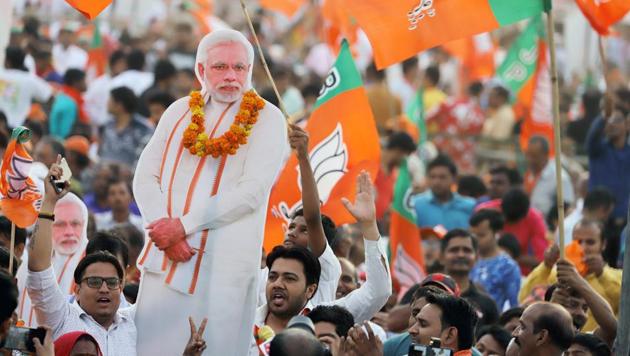How Narendra Modi conquered caste in 2019 elections
Lack of Muslim support for the BJP, Aadhaar-enabled direct cash transfers, EWS quota and the national security pitch contributed to diminished role of caste
Narendra Modi’s re-election and its sheer scale has challenged many truisms of Indian politics. The biggest question that has emerged is: Is the role of caste dwindling in Indian elections? It might be too early to answer the question definitively. One will need to observe subsequent assembly and Lok Sabha results to establish a firm trend. However, there are signs that caste played a diminished role in 2019 elections. The Bharatiya Janata Party (BJP) has won massive mandates in many states across India. As many as 15 states and the union territory of Delhi have returned more than 50% vote share for Modi’s party in the seats that it contested. In four more states, the BJP has notched up vote shares between 40% and 50%.

In a first past the post poll system involving a multipolar contest, it is often enough to secure around 30% votes to win a constituency. This has allowed political parties to cultivate just one or two castes or communities to win a seat in the legislative bodies. India’s poor performance in the delivery of public goods is also a by-product of this system — patronage distribution for select groups has proven to be sufficient for parties facing the electorate. But the BJP’s vote percentages show that it has been able to build large, cross-caste coalitions in many states. Four different factors are contributing to this phenomenon.
First, the BJP starts with a significant disadvantage of lack of Muslim support. While the party is itself responsible for this problem, it nevertheless has to work harder among the rest of the population to win a constituency. The need for Hindu consolidation increases even more when Opposition parties enter into an alliance as they did in the state of Uttar Pradesh (UP). Samajwadi Party (SP) is traditionally known to bank upon Other Backward Classes (OBCs) and Muslims, and the Bahujan Samaj Party (BSP) has had a firm grip on Dalit votes. In order to win UP — both at the state and the Centre — the BJP had to prise non-Yadav OBC votes away from the SP and non-Jatav Dalit votes away from the BSP. Given the BJP’s performance in 2019 — 50.8% vote share on the seats it contested in the state — it won’t be surprising if a significant number of Yadavs and Jatavs too voted for the party.
Second, the Modi-led National Democratic Alliance (NDA) government has decisively shifted to delivery of welfare benefits through Aadhaar directly into bank accounts of beneficiaries. This move has cut out the role of an intermediate layer of bureaucracy that practised patronage politics, in which a few castes benefitted disproportionately. This was the actual rationale behind the idea of Aadhaar as welfare benefits were prone to significant leakages. Even though Aadhaar was the brainchild of the United Progressive Alliance government, its rollout for welfare delivery was massively accelerated by the NDA government.
Third, the Modi-led NDA government brought in specific policies and schemes which further diluted the role of caste. The biggest move was the quota for the economically weaker sections (EWS) that was introduced through a Constitutional amendment in January this year. Through the EWS quota, as Rajeev Mantri and Harsh Gupta wrote in these pages, the government emphasised that “economic backwardness in and of itself is a sufficient criterion for government mandated affirmative action; it is not social identity alone that determines welfare”. Other successful schemes too focused on identities other than caste. For instance, the Ujjwala scheme to provide LPG cylinders to poor households benefitted women from all castes and communities.
Fourth, the sheer popularity of Modi was itself a huge determinant of this election. The image of Modi as a decisive and strong leader is something that has massive appeal across identities. He is seen as a leader who delivers robustly on national security and has enhanced the image of India in the international community. It is true that serious scholars question the slow process of defence modernisation. Even the efficacy of the Balakot airstrikes is far from settled. However, the masses are convinced that Modi is the protector of India’s sovereign and security interests. National security, it must be remembered, is the ultimate public good. It is non-rivalrous, that is, consumption of national security by one individual (or caste) doesn’t leave less of it for another individual (or caste). More importantly, it is non-excludable, that is, no individual or group (or caste) can be excluded from enjoying the benefits of national security.
Given these factors at play, it is no surprise that Modi was able to build large cross-caste coalitions in so many states. The role of caste may not have completely vanished but a set of circumstances, leadership and policy choices definitely contributed to diminishing its importance in the 2019 elections. Whether this trend continues or not will be interesting to see.
kunal.singh@htlive.com






